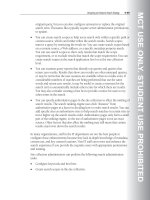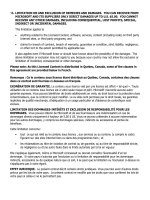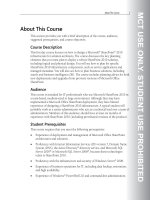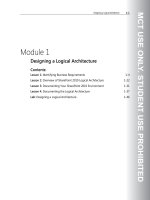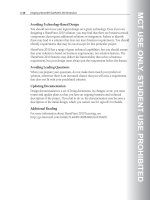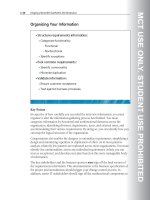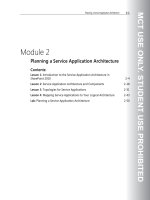Designing a Microsoft SharePoint 2010 Infrastructure Vol 1 part 21 docx
Bạn đang xem bản rút gọn của tài liệu. Xem và tải ngay bản đầy đủ của tài liệu tại đây (760.69 KB, 10 trang )
MCT USE ONLY. STUDENT USE PROHIBITED
Planning for Performance and Capacity 3-67
2. In the E:\Labfiles\Lab03\Starter\ folder, read the information under Dataset
in the Right-Sizing SharePoint Server 2010 Deployments section of the
SPServer2010CapacitySizingOverview.docx file.
f Task 2: Complete the Capacity worksheet in the Performance and
Capacity Planning Worksheet.xlsx file
• In the Performance and Capacity Planning Worksheet.xlsx file, in the
Capacity worksheet, complete the details to establish the database storage
requirements.
MCT USE ONLY. STUDENT USE PROHIBITED
3-68 Designing a Microsoft® SharePoint® 2010 Infrastructure
Module Review and Takeaways
Review Questions
1. What are the two tools that you can use to measure the performance of a WFE
server in a SharePoint test farm?
2. When you calculate content database size, you must estimate the number of
stored documents. Should you estimate the number of versions of documents
that you will keep?
3. What is the maximum recommended size for a content database?
4. What is the BLOB cache?
5. Is the SharePoint search index stored in a database?
MCT USE ONLY. STUDENT USE PROHIBITED
Planning for Performance and Capacity 3-69
Best Practices Related to Performance and Capacity Planning
Supplement or modify the following best practices for your own work situations:
• Understand your user requirements.
• Establish your organization’s performance and capacity requirements.
• Deploy a test farm for performance testing on similar hardware to your
production environment.
• Estimate the content database size through calculation or from existing storage
requirements.
• Limit database size to 200 GB.
• Limit site collection size to 100 GB.
• Plan storage for transaction logs.
• Plan storage for service application databases.
• Enable BLOB caching for digital assets.
MCT USE ONLY. STUDENT USE PROHIBITED
MCT USE ONLY. STUDENT USE PROHIBITED
Designing a Physical Architecture 4-1
Module 4
Designing a Physical Architecture
Contents:
Lesson 1: Designing Physical Components for SharePoint Deployments 4-4
Lesson 2: Designing Supporting Components for SharePoint Deployments 4-20
Lesson 3: SharePoint Farm Topologies 4-27
Lesson 4: Mapping a Logical Architecture Design to a Physical
Architecture Design 4-37
Lab: Designing a Physical Architecture 4-47
MCT USE ONLY. STUDENT USE PROHIBITED
4-2 Designing a Microsoft® SharePoint® 2010 Infrastructure
Module Overview
When you design a Microsoft® SharePoint® 2010 deployment, you must carefully
consider the hardware and farm topology requirements. Your choices of server
hardware and the number of servers that you specify for the farm can have a
significant impact on how the farm meets user requirements, how users perceive
the SharePoint solution, and how long before the farm requires additional
hardware.
This module describes the factors that you should consider when you design the
physical architecture of a SharePoint 2010 deployment. The physical architecture
refers to the server design, farm topology, and supporting elements—such as
network infrastructure—for your deployment. This physical architecture underpins
the operations of your SharePoint 2010 environment, so it is essential that your
physical design fully meets the operational requirements.
MCT USE ONLY. STUDENT USE PROHIBITED
Designing a Physical Architecture 4-3
Objectives
After completing this module, you will be able to:
• Describe the physical design requirements for SharePoint 2010.
• Describe the supporting requirements for a successful SharePoint 2010
physical design.
• Identify SharePoint farm topologies.
• Map a logical architecture design to a physical architecture design.
MCT USE ONLY. STUDENT USE PROHIBITED
4-4 Designing a Microsoft® SharePoint® 2010 Infrastructure
Lesson 1
Designing Physical Components for SharePoint
Deployments
Before committing to specific numbers of servers, you must understand the basic
hardware and software requirements. In addition, you should also consider
options such as server virtualization and disk storage choices because these
choices will have a fundamental effect on management options and the planning of
high availability. You should also note that there may be nonfunctional, or implicit,
requirements that the organization expects from the SharePoint deployment.
Identifying these nonfunctional requirements is an important step toward
establishing the best design and gaining user adoption.
Objectives
After completing the lesson, you will be able to:
• Identify minimum hardware requirements.
• Identify software requirements.
MCT USE ONLY. STUDENT USE PROHIBITED
Designing a Physical Architecture 4-5
• Identify server virtualization options.
• Identify storage choices.
• Identify database configuration options.
• Map functional and nonfunctional requirements to your design.
MCT USE ONLY. STUDENT USE PROHIBITED
4-6 Designing a Microsoft® SharePoint® 2010 Infrastructure
Hardware Requirements
Key Points
The following table shows the hardware requirements for Web Front End (WFE)
servers, application servers, and single-server installations.
Component Minimum requirement
Processor (CPU) 64 bit, four cores.
Memory (RAM) 4 gigabytes (GB) for developer or evaluation use.
8 GB for production use (single-server or multiple-server farm).
Hard disk 80 GB for the system drive.
In production use, you will require additional disk space for daily
operations. You should maintain twice as much free disk space as
RAM.
In multiple-server farms, database servers should use the minimum requirements
that are shown in the following table.
